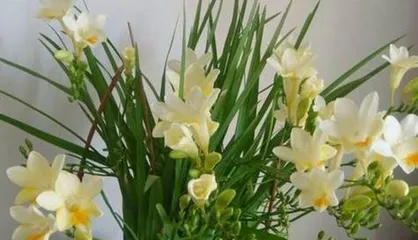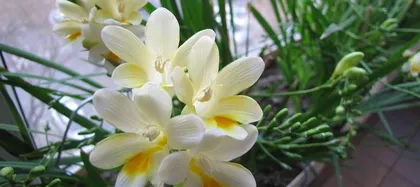Freesia is a relatively difficult orchid variety to cultivate, but as long as you master some care techniques, you can make it grow more lush and its flowers more vibrant. This article will share freesia care tips to help enthusiasts create a sea of freesia flowers.

I. Choose an Appropriate Environment
Freesia is suitable for growing in an environment with stable indoor temperature, high air humidity, and good ventilation. Avoid placing it in direct sunlight or next to air conditioning vents.
II. Choose the Right Soil and Potting Mix
Freesia prefers a well-draining and airy medium, such as humus soil mixed with pine needles, ferns, and peat. The potting mix should be loose, breathable, and not easily compacted.

III. Master Watering Techniques
Freesia likes a moist environment but does not like waterlogging, so it is important to water moderately and evenly. Water once a week in spring and summer, and reduce to once every half month in autumn and winter.
IV. Do Not Over-fertilize
Freesia has a long growth period and requires regular fertilization, but not in excess. It is recommended to fertilize once a month in spring and summer, and once every two months in autumn and winter.
V. Pay Attention to Light
Freesia prefers an environment with ample light but needs to avoid strong direct sunlight. It is recommended to place it in a south-facing position and use a shade net for protection.

VI. Pay Attention to Pest and Disease Control
Freesia is relatively susceptible to pests such as aphids, whiteflies, and red spider mites. It should be checked regularly and timely control measures should be taken.
VII. Prune to Promote Metabolism
Pruning old, pest-damaged, or diseased parts of the freesia can effectively promote its metabolism and help it grow stronger.
VIII. Master the Balance of Temperature and Humidity
Freesia is a tropical plant and is sensitive to the balance of temperature and humidity. In a dry environment, you can use a humidifier or place it on a tray of water and pebbles for proper adjustment.
IX. Pay Attention to Repotting Time
Freesia grows relatively fast and requires regular repotting. Generally, it should be repotted once a year, preferably in spring, to allow for better growth in the new season.
X. Master Propagation Techniques
Freesia can be propagated by division, grafting, and other methods. Division is best done in spring, using a sharp knife to separate new plantlets and then planting them in fresh potting mix.
XI. Pay Attention to Environmental Hygiene
Freesia prefers a clean and hygienic environment, so it is necessary to regularly clean up fallen leaves and dead branches to keep the surroundings tidy.
XII. Master Orchid Arrangement Techniques
As a member of the orchid family, freesia can be grown with other orchid varieties to create a more splendid and colorful floral world.
XIII. Pay Attention to Dormancy Care
Freesia easily enters a dormant period in winter. At this time, it is necessary to appropriately reduce watering and fertilizing, maintain the balance of environmental temperature and humidity, and resume care in the spring.
XIV. Master Disease Identification and Treatment
Common diseases in freesia include root rot, leaf spot, and anthracnose. They must be identified and treated promptly to avoid affecting their growth.
XV.
Caring for freesia requires attention to multiple aspects such as temperature, humidity, and light. Regular fertilizing, repotting, and pruning are necessary, along with pest and disease control and environmental hygiene. Only by mastering these techniques can you grow your freesia into a premium plant.